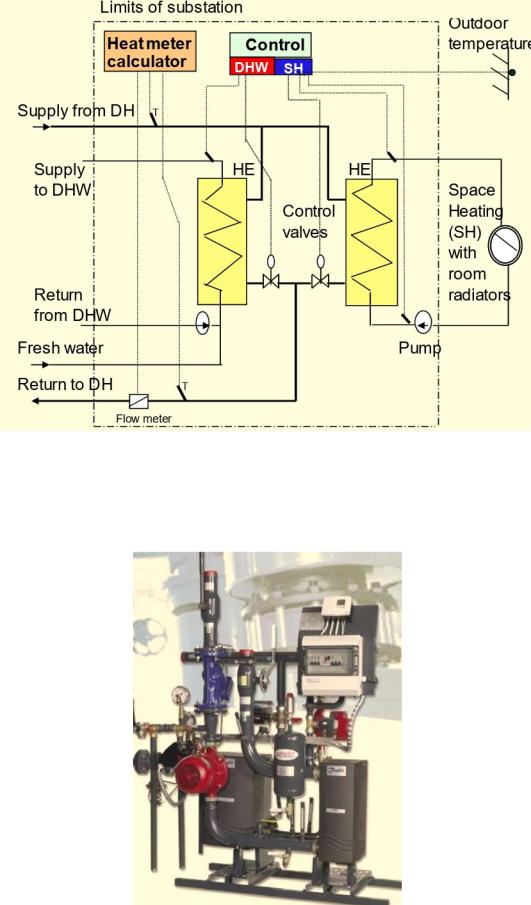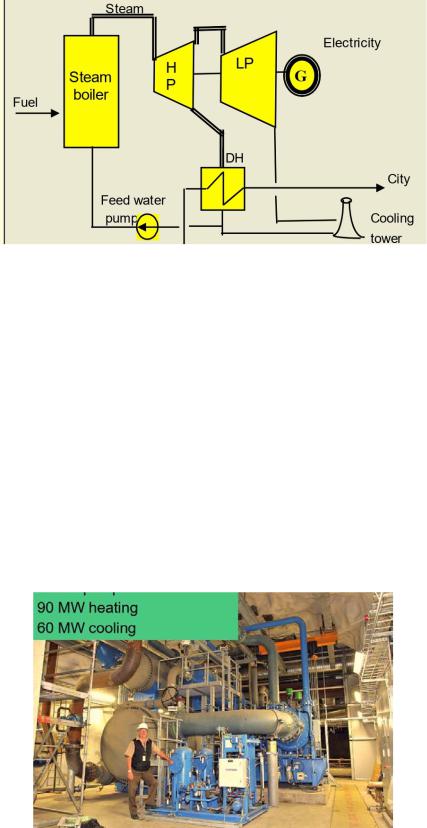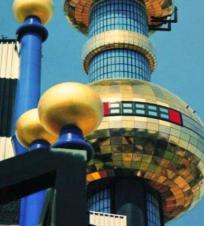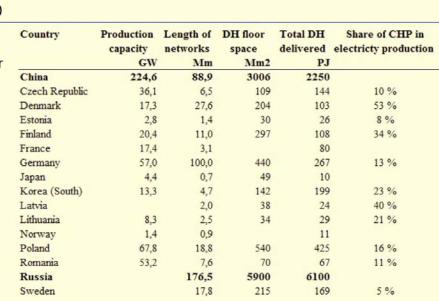
- •PART 1. TASKS CONNECTED WITH TEXT ANALYSIS
- •LESSON 1. THE COLUMN
- •LESSON 2. BIOENERGY PLANT
- •LESSON 3. GREEN, GREENER, THE GREENEST
- •LESSON 4. PROTECTION
- •LESSON 5. THE DISTRICT COOLING POTENTIAL
- •LESSON 6. FROM VISION TO OPERATION
- •LESSON 7. HOW IS DC PRODUCED?
- •LESSON 8. SOCIETY IS STAKE
- •LESSON 9. HYDROLIC SAFETY ANALYSES
- •LESSON 10. THE MIDDLE EAST
- •PART 2. PROFESSIONAL ORIENTED TASKS
- •Библиографический список
- •ПРИЛОЖЕНИЕ
PART 2. PROFESSIONAL ORIENTED TASKS
1. Read the definition and write your own.
Definition of district heating(DH):
Interconnection of various heat sources to customers by means of hot water (or steam) networks to serveroom space heating(SH) and usually domestic hot
water(DHW) as well.
СибАДИ2. Read about benefits provided by DH and add the list.
Benefits provided by DH:
Economy of scale:
•By connecting many customers with varying heat demands, central plant runs continuously instead of many individual plants running sporadically.
•Biomass and waste incineration are most feasible at large-scale. Environment:
•Centralized plant almost certainly has higher efficiency than many individual plants •Enables surplus heat to be recycled instead of thrown away.
•Flexibility enables many low carbon and renewable heat sources to be used...
•...including combined heat and power production which is the only way to generate electric power at 90+ % efficiency.
•High quality flue gas cleaning is possible at large plants. Safety:
•No flue gases nor fuel explosion risk at customer premises. Reliability:
•Having several heat sources and looped networks interconnected, the reliability is very high.
Maintenance:
•Centralized plant can be continuously monitored and pro-actively maintained.
•Long lifetime: well-maintained DH networks last at least 50 years.
3. Get acquainted with requirements and find information about parameters valid in Russia.
General Requirements of DH:
High heat load density: as heat networks are very capital intensive (3001200€/m), the heated area has to be densely built to minimize the required pipelength •Economic viability: As a rule of thumb the heat load density for DH should be higher than 2 MWh per meter of planned network length to be commercially viable •Location of buildings: the buildings to be connected to the DH networks should be close to the existing network to minimize the connection pipe length. This will reduce both investment and operational costs •Location of heat sources: modern heat sources have high quality flue gas cleaning systems. Therefore, subject to planning conditions, heat sources can be located near or in
32
the centre of urban areas to minimize network length. The location of the heat sources has to be agreed in advance
Land use requirements: it is very useful to develop a heat demand map, and a corresponding heat plan for a town or city to identify which areas are most suitable for DH, and which areas are best served by individual building systems •Heat sources should be close to the customer (economy) but should take into account noise prevention and transportation logistics •Underground networks
СибАДИrequire space that is already partly occupied by other infrastructure: e.g. electricity, telecommunications, sewage, water •Possible booster pump stations •Fuel and ash transportation routes should minimize any harm and risk to the population.
Municipal support is needed: Enabling access to roads and public land to build networks and heat sources •Ensuring municipal buildings are connected to the DH system wherever possible
Modern DH with looped network: Heat can be delivered to most customers from two directions, increasing security of supply. Several heat sources connected to the same network also increases security. Different fuel/heat source combinations can be used in parallel to minimize fuel costs •Fuels are handled centrally, so that fire and explosion risks in buildings are avoided.
Customers: A contract is needed with the customer that stipulates the rights and responsibilities of both parties: the heat supplier and the heat customer. The customer representative must have access to the substation room at any time in order to adjust the control system as needed and supervise the overall condition of the substation. The heat supplier has to have access to the substation room at any time in order to read the heat meter and supervise the overall condition of the substation.
4. Read about consumer substation functions then analyze the scheme and describe the process using the scheme.
Consumer substation -main functions.
• Heat exchangers (HE) keep the water circulation in the primary network separate from that in the secondary network.
• Space heating (SH) controls regulate the supply temperature (secondary side) according to outdoor temperature.
• Domestic hot water control keeps the DHW water temperature constant at about 55oC.
• Heat meter: calculates and stores energy consumption, using information from the flow sensor and temperature.
33

СибАДИConsumer substation – main functions
5. Look at the picture and put the proper color in to description (then check your answers).
34

Consumer substation – main components:
•The …boxes at the bottom are the heat exchangers for SH and DHW
•The third box between the heat exchangers is the cylindrical expansion vessel
•The … box above is the temperature controller
•The … unit on the left is the DHW circulation pump •The … unit on the left is the mud filter
СибАДИTechnical features of DH. Water temperatures: DH supply water ranges from 80 to 120C and the return water from 30 to 70oC depending on the system and weather conditions. Pressures: the nominal pressure levels are typically 16 bar (1,6 MPa). Pipelines: Two main types as follows: 1. Modern pre - insulated pipelines comprise a steel pipe covered by poluyurethane thermal insulation and polyethylene jacket pipe. 2.Olderpipelines were installed in concrete channels, where the steel pipe is covered by mineral wool. Speed of water: the velocity of water circulating in the pipelines is usually below 2 m/s. Therefore, it may take several hours to reach the customer at the far end of the network. Heat losses: the heat losses from modern networks usually range from 5 to 10% of the produced heat.
•The heat meter is missing in the picture but will be delivered by the heat
supplier.
Check yourself:
•The grey boxes at the bottom are the heat exchangers for SH and DHW
•The third box between the heat exchangers is the cylindrical expansion vessel •The white box above is the temperature controller •The red unit on the left is the DHW circulation pump •The blue unit on the left is the mud filter •The heat meter is missing in the picture but will be delivered by the heat supplier.
6. Give a title to each paragraph (then check your answers).
Technical features of DH:
• |
: DH supply water ranges from 80 to 120C and the return water |
|
from 30 to 70oC depending on the system and weather conditions |
||
• |
: the nominal pressure levels are typically 16 bar (1,6 MPa) |
|
•Pipelines: Two main types as follows: |
|
|
1.Modern |
pre-insulated |
comprise a steel pipe covered by |
poluyurethane thermal insulation and polyethylene jacket pipe |
||
2.Olderpipelines were installed in concrete channels, where the steel pipe is |
||
covered by mineral wool. |
|
|
• |
: the velocity of water circulating in the pipelines is usually |
|
below 2 m/s. Therefore, it may take several hours to reach the customer at the far |
||
end of the network. •Heat losses: the heat losses from modern networks usually |
||
range from 5 to 10% of the produced heat. |
|
|
Check yourself: |
|
|
35

7. Look at the scheme and describe the further trends.
СибАДИ8. Read the definitions and learn it by heart.
Definition of CHP:
CHP – Combined heat and power when useful heat and electricity are produced from the technical process of the plant
Trigeneration is when both heat and cold as well as electricity are produced from the technical process of the plant.
District cooling with CHP requires an absorption chiller, which uses heat as the driving force to produce cold water.
9. Study the scheme and tell us what CHP plant is used for.
36

10. Read and define: is it about advantages or about disadvantages?
Separate supply of electricity and district heating:
The heat losses of power-only generation based on any fuel are substantial, 1–3 times the gained electric power.
The factor depends on the fuel and type of the plant as follows:
1 = for combined gas and steam fuelled power plants and gas/diesel engines
(picture above); СибАДИ2 = for modern solid fuel power plants;
3 = for nuclear and small power plants.
11. Study the scheme and learn more about separate production.
12. Study the scheme and comments, and define: is it about advantages or about disadvantages of CHP?
Combined heat and power (CHP).
• The same amount of sold energy to customers as in the previous slide (100 and 100).
• Fuel consumption (222) 30% less than without CHP (310).
• The quantitative fuel savings vary but 30% is independent on the type of fuel or the plant.
37

13. Look at the picture and describe the process of power production.
СибАДИ14. Read the definition and learn it by heart.
Definition of district cooling (DC): Interconnection of various cooling sources to customers by means of either hot or chilled water or even steam networks to serveroom space cooling.
15. Correct the mistakes in word divisions.
RationaleofDCprovidesthepossibilityto:Usealmostcarbonfreecoolingsourcess
uchassea,lakeandgroundwater.Usethehotwaterorsteamnetworkinsummer,whenexc
essheatisavailable,tocoolbuildingsbymeansofabsorptionchillers,asortoffridgeinwhi
chheatisusedinsteadofelectricity.UsewasteheatreceivedfromtheDCsystembymeans
ofaheatpumptowarmupthereturnwatertemperatureoftheDHnetwork.Thus,theintegr ationofDH,DCandCHPcreatestri-generationin whichheating,coolinganelectricityareprovidedathighoverallefficiencyandwithonlylowfluegasemissions(andlowcarbo nemissionsin particular).
DC combined with DH and CHP requires heat pumps
Example of heat pump plant in Helsinki
•Heat pump plant may produce both heating and cooling in the same process. •Utilizes purified sewage water and sea water.
38

16. Study the scheme and give Russian equivalents for each part.
СибАДИ17. Identify each bar on the diagram using the word below.
Heat pump, DH system, coal CHP, oil and gas boiler, gas CHP, combined heat pump.
Check your answers.
39

18. Put the devices and systems into right order according to CO2 emissions of heating options (from the least polluting to the most polluting).
Heat pump, DH system, coal CHP, oil and gas boiler, gas CHP, combined heat pump.
Look at the diagram and check your answers.
СибАДИ19. Describe advantages of DH according to given criteria.
Check your answers.
40

20.What should we do to achieve efficient network?
21.What should we do to achieve efficient production?
22.What should we do to achieve sustainable environment?
23.What should we do to achieve financial viability?
24.Read and translate.
Some other tools to achieve in practice the goals described above. СибАДИ•Planned preventive maintenance contributes to longevity of the fixed assets, and
reduces the cost of maintenance. The lifetime of the pipelines can be 50 years or more. •High quality of circulation water is vital to eliminate corrosion and blocking of pipelines
and armatures •Advanced IT systems used in operation, maintenance and financial administration may substantiallyreduce man-power needs and improve the quality.
•Economy of DH depends on the length of the DH network. •Competitiveness depends on the relative prices of electricity (HP), gas (GH) and DH.
25. Read the text and give the title.
The heat pump requires electricity. This is actually generated by the local CHP plant – even though purchased from the grid. The heat energy produced by the heat pump reduces the heat production of the CHP plant A part of the CHP power turns to separate (condensing) power due to reduced CHP heat production The heat pump needs electric energy to generate heat. The primary energy consumption increases while the heat pump takes over heat load from the CHP plant.
26. Get acquainted with municipal waste incineration practice in Vienna, Austria.
•Three waste incineration plants. •Municipal waste as fuel.
•Wien Energy – company handles 800.000 tons of various waste annually. •The plants are situated inside the city area.
•The plant is located near to a large hospital (200 m). •Tourist attraction
The waste incineration plant was designed by the architect Hundertwasser
41

27. Get acquainted with the best practice with DHC and CHP. Helsinki, Finland.
Comprehensive DHC and CHP:
•DH covers 93% of the total heat demand in Helsinki with the remainder coming from individual heat pumps, oil and electric heating.
•1230 km of underground heating networks and more than 10.000 customers (buildings) exist in the integral DH system.
•More than 90% of DH energy is produced by CHP. СибАДИ•The annual energy efficiency of CHP exceeds 90% which is one of highest
in the world.
•7 large CHP units, 5 heat pumps and more than 10 peak load boilers are connected to one integral network.
•Fast expanding district cooling system despite being a capital with cold climate conditions.
•The EU has ranked DHC and CHP in Helsinki as Best Available Technology.
28. Get acquainted with DH and CHP international statistics.
29. Match countries with problems.
1. Strong growth while replacing small and polluting coal fired boilers with DH and facilitating expanding cities with DH services
2. Growing need to modernize the existing old and deteriorated DH systems to reduce losses and improve reliability
3. Small DH systems exist mainly between state owned buildings (hospitals, military, university, office) but not much on residential area. Low prices of energy and low interest at private sector and relatively weak municipalities make DH expansion challenging.
A) The USA and Canada В) China С) Russia
42
